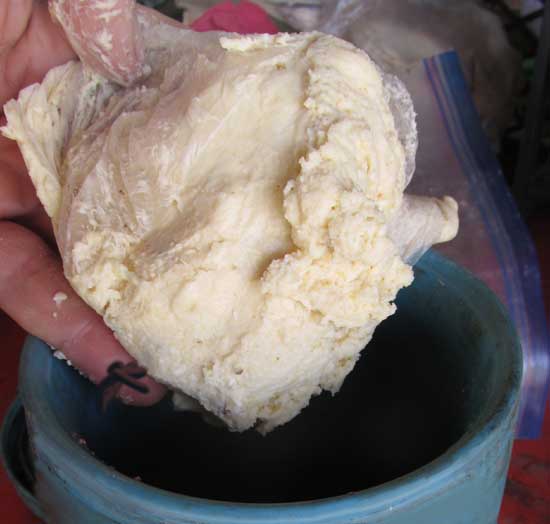Excerpts from Jim Conrad's
Naturalist Newsletter
from the March 26, 2017 Newsletter issued from Rancho Regenesis near Ek Balam Ruins 20 kms north of Valladolid, Yucatán, MÉXICO
SOUR POZOL
At www.backyardnature.net/n/p/080421.htm I describe an awkward situation I experienced in Chiapas in 2008 when my Tzotzil-speaking hosts offered me a drink of what they called pozol agria. Their pozol agria was made by dissolving rancid masa in water. Masa is moist and dough-like, made from ground corn, or maize, and is what tortillas are made from. Traditionally the corn kernels used making masa are softened by soaking overnight, but nowadays in Mexico probably most masa is prepared from commercially packaged, dry, ground corn, in stores sold under the brand name of Maseca.
In the name pozol agria, the word agria generally means "sour," though according to my dictionary sometimes it can mean "bitter." My Chiapan pozol agria was bitter, not sour, so I came away from the experience thinking of the drink as "bitter pozol." However, a while back here on the rancho I decided to give pozol agria another chance. One day in town I bought a kilo of masa at a tortillaría, stored it in a warm to hot place for several days. After just three days of Yucatan heat, already it was tasting good, and after five or six days it seemed at its peak. In cooler areas, the masa needs more time. When my masa was ready I dissolved the resulting paste into a mug of water, I was astonished that instead of tasting bitter, it tasted a lot like buttermilk. Below, you can see what an apple-sized hunk of masa looks like when squeezed it from its plastic bag into a mug:

I'm unsure why my Chiapan pozol agria was bitter but my Yucatec drinks turn out sour. The Chiapan drink was ground from locally grown fresh corn and may have undergone bacterial action for a longer time than my rancho drinks, whose masa seems to be made from dried, finely ground corn freshly soaked in water and kneaded, plus I let my rancho masa sit for fewer days.
Each hot afternoon I look forward to my big mug of pozol agria. Somehow the taste hits the spot, plus -- despite knowing that it may be purely psychological -- I always feel a nice, healthy glow after drinking it.
Actually there's a reason why pozol agria might be good for us: During those days when the masa sits in its quiet, warm place, microbial action makes available certain vitamins and other nutrients not found in regular masa, or found in much smaller amounts. I think we're talking about fermentation here, and probably you've heard how fermentation makes most any food more nutritious.
So, if you're living near a tortillaría or can make your own masa from the dry powder sold in markets as Maseca, you might give pozol agria a try. When I buy it at a tortillaría -- and it's remarkably inexpensive -- they dump a kilo of paste into a plastic bag. At home I transfer the masa to a covered bowl or else put the bag into a more substantial bag before setting it aside to ferment. That's because tiny, fruit-fly-like insects attracted to sourness come out of nowhere to feed on the masa and lay eggs on it, and they can chew through the tortillaría's flimsy bag. If somehow those flies reach your masa, in a few days when you make your pozol agria you might find tiny, white maggots floating in your drink.
I pour pozol agria onto bowls of granola, and can imagine that it would make homemade bread taste as if it were made with buttermilk. I really think that pozol agria has a future as an exceptionally nutritive, not-bad-tasting, inexpensive drink among us gringos. And instead of thinking of it as "bitter pozol," we'd do better to call it "sour pozol."
from the August 13, 2017 Newsletter issued from Rancho Regenesis in the woods ±4kms west of Ek Balam Ruins; elevation ~40m (~130 ft), N20.876°, W88.170°; north-central Yucatán, MÉXICO
FERMENTED MASA UPDATE
Nowadays I'm no longer drinking sour pozol because I've learned a new way to use the fermented masa, one that agrees with me even more than making it into a drink.
My favorite breakfast is a bowl of granola with fruit. Years ago in Germany I learned to add something called quark to the granola. Quark is something I've only seen in Germany, but there it comes in many tastes and is found in every food market. It's like yogurt, but with a cheesy taste. Once I got to liking it on my granola, when I was in the US where quark wasn't available, I bought buttermilk as a granola-topping substitute. Down here where neither buttermilk nor quark are handy, I've discovered that by adding a dollop of fermented masa atop the granola, then with a spoon agitating the masa until it forms an emulsion, the result is just as good as with quark and buttermilk.